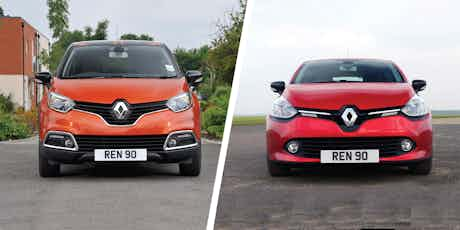Renault Captur vs Clio – sibling show-down
October 07, 2015 by carwow staff

Renault has gone through something of a rejuvenation in recent times. Since 2012, the brand has seen a 14 per cent increase in sales year-on-year – well above the market average.
Two of the largest reasons (albeit two of the smallest in stature) are the pair of cars you see here. The fourth generation Clio has continued where its predecessors left off, while the Captur has opened up a new segment for the brand. So if the choice was yours, would you choose the Clio or the Captur? We’re comparing the two to help you decide.

Styling
With both cars originating from the same brand, it isn’t surprising to see a number of similarities between the two designs. This is most obvious at the front, where the pair flaunt a very similar grille featuring a large Renault badge in the centre. Other cues, like the curvy side sills and a window line that sweeps upwards towards the rear of the car, are present on both.
The Clio looks more squat and sporty – especially at the rear, while touches like the optional contrasting roof and extra flashes of chrome-effect trim helps give the Captur some added character.
Interior
Like the outside, moving from the cabin of the Clio to the Captur (or vice versa) reveals many familiar touches. The steering wheel design, instrument binnacle and heating controls are interchangeable, along with many other smaller components.
The Captur’s raised driving position (as with other crossovers) goes down well with buyers, and gives a better view of the road ahead than the Clio. What might be less appreciated in both cars is the quality of some of the plastics – those used around the lower part of the dash in particular feel rather hard and scratchy.
The Captur’s larger body helps it to accommodate passengers more easily inside. It’s the boot which gains the most, though – while the Clio’s 300 litres is good for its class, the Captur offers 377 litres. The Captur’s rear bench can be adjusted along a sliding rail, which means those willing to sacrifice a little leg room can increase that space to as much as 455 litres.
Driving
Under the skin, the two cars share the same platform, along with much of the suspension and braking components too. As a result, the pair feel largely similar from behind the wheel. Testers note that both deliver a sharp drive, and a ride/handling balance that’s among the best in their respective classes.
Overall, though, the Clio is the better car to drive. It hauls almost 100kg less than the equivalent Captur, and its mass is centred closer to the ground. These two factors mean that not only is the impression of body roll less pronounced in the Clio, but it changes direction more keenly, too.
Some testers complain, however, that the steering is a little too light for motorway driving, making the pair feel nervous at high speed, and that larger wheel/tyre combinations result in high levels of road noise.
Engines
Like the rest of the oily bits, the Clio and Captur use similar engine lineups. There are two exceptions – the Clio is available with an entry-level 1.2-litre petrol engine with 74hp, while at the opposite end of the scale sits the RenaultSport Clio 220 which, thanks to a turbocharged 1.6-litre petrol engine and dual clutch automatic gearbox, will sprint from 0-62mph in 6.6 seconds.
Generally, the pick of each range is the 1.5-litre turbodiesel. Claimed to return 76.4mpg in the Captur and 83.1mpg in the Clio, it’ll keep running costs impressively low, while offering enough torque for those occasions when you need to carry a few passengers. Critics praise this engine for its petrol-like response and ease of use.
Value for money

Despite their differing appearances on the outside, prices of the Clio and Captur aren’t significantly different. Taking the 0.9-litre petrol in Expression+ trim as an example for both, the Clio is £620 cheaper than the Captur. Prices for top of the range models, meanwhile, are closer to £1,000 less for the smaller car.
The Clio should be cheaper to run, too. The Captur’s added weight makes it less frugal, while its insurance groups generally sit one or two steps higher, too. From a safety point of view, both are excellent – the Clio and Captur have been awarded five-star safety ratings from Euro NCAP.
Verdict
Given that the two cars are so similar underneath and assuming you don’t need the extra space, we’d recommend choosing the Clio – it’s lighter, more efficient, faster, more fun to drive and cheaper to buy than the Captur.
Nevertheless, if you need a car with more passenger and boot space, the Captur is the obvious choice. It’s almost as fast, efficient and stylish as the Clio but with levels of practicality that families can actually use.
Save money on your Renault Captur or Clio
Put either the Renault Captur or the Renault Clio in our car configurator to see how much carwow could help you save. For more options, head over to our deals page or, if you still need help picking your next car, check out our car chooser.















